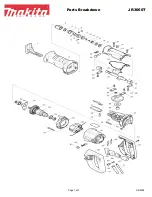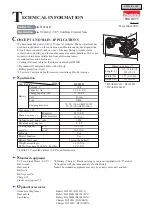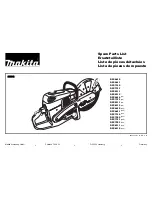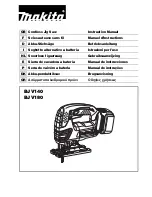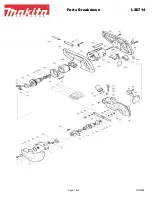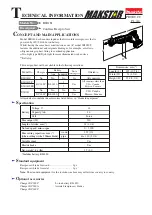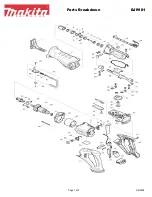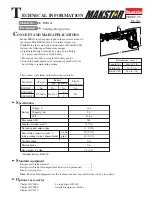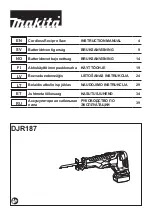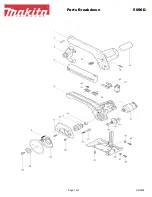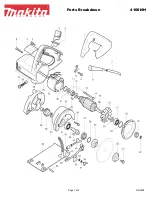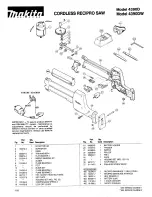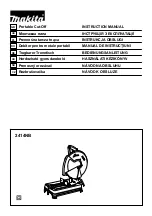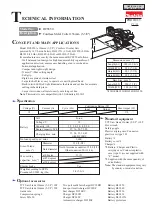
11
GB/IE/NI
10.4.5 Calibrating the parallel stop (fig. 21+21a)
ATTENTION:
Take off the saw blade guard (2) (see 9.4).
1. Set the saw blade (4) to the maximum cutting depth.
2. Set the parallel stop (14) such that the stop rail (30) makes
contact with the saw blade (setting for thick material, see
10.4.3).
If the parallel stop (14) is not in line with the saw blade (4),
proceed as follows:
1. Loosen the bolts (k) on the parallel stop sufficiently that
the parallel stop (14) can be aligned parallel to the saw
blade (4).
2. Tighten the bolts (k) again.
10.5 Using the transverse stop (fig. 22)
When trimming, the transverse stop (31) must be extended
from the parallel stop (14) with the stop rail (30).
1. Slide the transverse stop (31) in the groove (28a) of the saw
table.
2. Loosen the knurled screw (29).
3. Turn the transverse stop (31) until the desired angule has
been set. The notch on the guide rod indicates the set angle.
4. Retighten the knurled screw (29).
5. To extend the transverse stop (31) with the stop rail (30),
the stop rail (30) must be removed from the parallel stop
(14). Now mount the stop rail as shown in fig. 22 using
the knurled nuts (i).
ATTENTION:
Do not push the stop rail too far toward to the
saw blade. The distance between the stop rail (30) and the
saw blade (4) should be approx. 2 cm.
10.6 Setting the scale of the parallel stop (fig. 23)
Check whether the indicator on the sight glass (32) of the par-
allel stop (14) shows correct values in relation to the cutting
line. If this is not the case, proceed as follows:
1. Loosen the screw (32a) which fixes the indicator to the
sight glass (32) of the parallel stop (14). Now the in-
dicator on the sight glass (32) can be set to the correct
position.
2. Now retighten the screw (32a) on the sight glass (32).
11. Using the equipment
11.1 Working instructions
• After each new adjustment it is advisable to carry out a trial
cut in order to check the set dimensions.
• After switching on the saw, wait for the blade to reach its
maximum speed of rotation before commencing with the cut.
• Secure long workpieces against falling off at the end of the
cut (e. g. with a roller stand etc.).
• Take extra care when starting the cut.
• Never use the equipment without the suction function.
• Regularly check and clean the suction channels.
11.2 Suitability of the saw blades
• 24 teeth: soft materials, high degree of chip take-off, coarse
cutting pattern
• 48 teeth (not included in the scope of delivery): hard mate-
rials, lower degree of chip take-off, finer cutting pattern
11.3 Making longitudinal cuts (fig. 24)
Longitudinal cutting is when you use the saw to cut along the
grain of the wood. One edge of the workpiece will be pressed
against the parallel stop (14), while the flat side lies on the
saw table (1).
The saw blade guard (2) must always be lowered over the
workpiece. When making a longitudinal cut, never adopt a
working position that is in line with the cutting direction.
1. Set the parallel stop (14) and the stop rail (30) in accord-
ance with the workpiece height and the desired width.
2. Switch on the saw.
3. Place your hands (with fingers closed) flat on the work-
piece and push the workpiece along the stop rail (30)
into the saw blade (4).
4. Guide at the side with your left or right hand (depending
on the position of the parallel stop) only as far as the front
edge of the saw blade guard (2).
5. Always push the workpiece through to the end of the split-
ter (3).
6. The offcut piece remains on the saw table (1) until the saw
blade (4) is back in its position of rest.
7. Secure long workpieces against falling off at the end of
the cut (e.g. with a roller stand etc.).
ATTENTION:
The parallel stop must be set parallel with the
saw blade. Check the alignment and firm seating of the parallel
stop (14), particularly during use and after longer periods not
in use. Vibrations can loosen screw connections and change
the position of the parallel stop. If necessary, adjust the paral-
lel stop and tighten the knurled nut (i). Tighten the screw con-
nections (k) with the Allen key (not included in the scope of
delivery) (fig. 21a).
11.3.1 Cutting narrow workpieces (fig. 25)
Be sure to use a push stick (17) when making longitudinal cuts
in workpieces smaller than 120 mm in width. A push stick (17)
is supplied with the saw! Replace a worn or damaged push
stick (17) immediately.
1. Adjust the parallel stop (14) to the width of workpiece
you require.
2. Feed in the workpiece with two hands. Always use the
push stick (17) in the area of the saw blade.
3. Always push the workpiece through to the end of the split-
ter (3).
m
WARNING:
With short workpieces, use the push stick
from the beginning.
11.3.2 Cutting very narrow workpieces
Be sure to use a push block when making longitudinal cuts in
very narrow workpieces with a width of 30 mm and less. There
is no push block supplied with the saw! (Available from your
specialist dealer) Replace the push block without delay when
it becomes worn.
When sawing workpieces, these can become jammed be-
tween the parallel stop and the saw blade, be caught by the
saw blade, and be thrown from the machine. Therefore, the low
guide face of the parallel stop is best used in this case (see fig.
16). If required, change over the stop rail (see 10.4.2).































